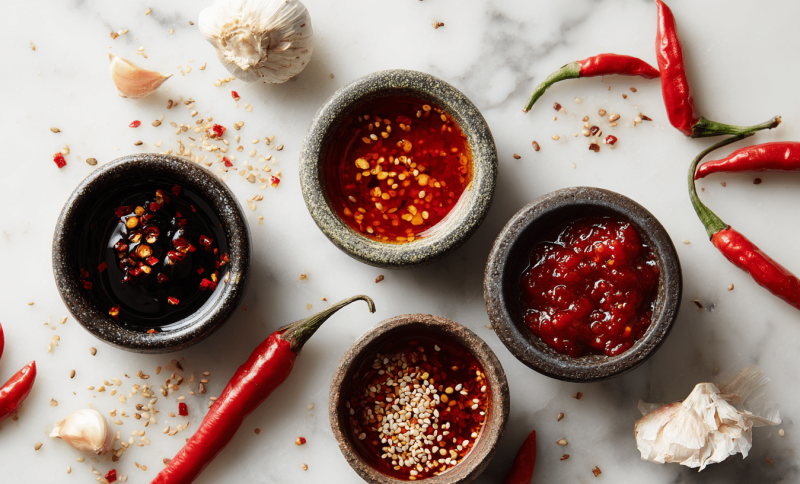Turn your kitchen into a flavor powerhouse with these four crowd-pleasing asian spicy recipes that satisfy every craving and cooking style.
From bold Szechuan sauces to aromatic chili oils to fiery Central Asian pastes, these recipes deliver authentic flavors with minimal effort and maximum satisfaction.
The magic happens when basic ingredients change into layers of heat and flavor, making every bite an exciting experience.
These four sauce recipes represent different regional approaches to heat and spice, each bringing unique characteristics that showcase the incredible diversity of Asian cuisine.
What makes these recipes special is their flexibility and shelf stability, ready to change any simple meal into something spectacular.
In this guide, you’ll master four crowd-favorite sauces:
- Bold Szechuan Spicy Sauce – sweet heat with complex five-spice warmth
- Rich Chiu Chow Chili Oil – aromatic oil that changes any dish
- Fiery Lazadzhan Paste – intense Central Asian heat that commands respect
- Bold Korean Gochujang Sauce – fermented umami fire for everything
Bold Szechuan Spicy Sauce that Brings the Heat
This sauce delivers all the complex flavors of Szechuan cuisine without complicated preparation.
The no-cook approach yields a flexible condiment that serves as a base for stir-fries, a dipping sauce, or a marinade, requiring minimal cleanup.
The addition of Chinese five-spice and maple syrup makes this a complete flavor experience that satisfies spicy food lovers while providing authentic Chinese taste in every drop.
What sets this sauce apart is its perfect balance of sweet, salty, spicy, and aromatic elements that work together to create something truly special.
The five-spice powder brings warm, complex notes that complement the heat beautifully, while the maple syrup adds a natural sweetness that’s distinct from regular sugar.
What You’ll NeedFor the Sauce Base:
For the Spice Blend:
|
Step-by-Step Instructions
This sauce builds layers of Szechuan flavor with simple mixing techniques that anyone can master. The key is to achieve proper balancing and tasting to create your perfect heat and sweetness profile.
1. Combine All Wet Ingredients
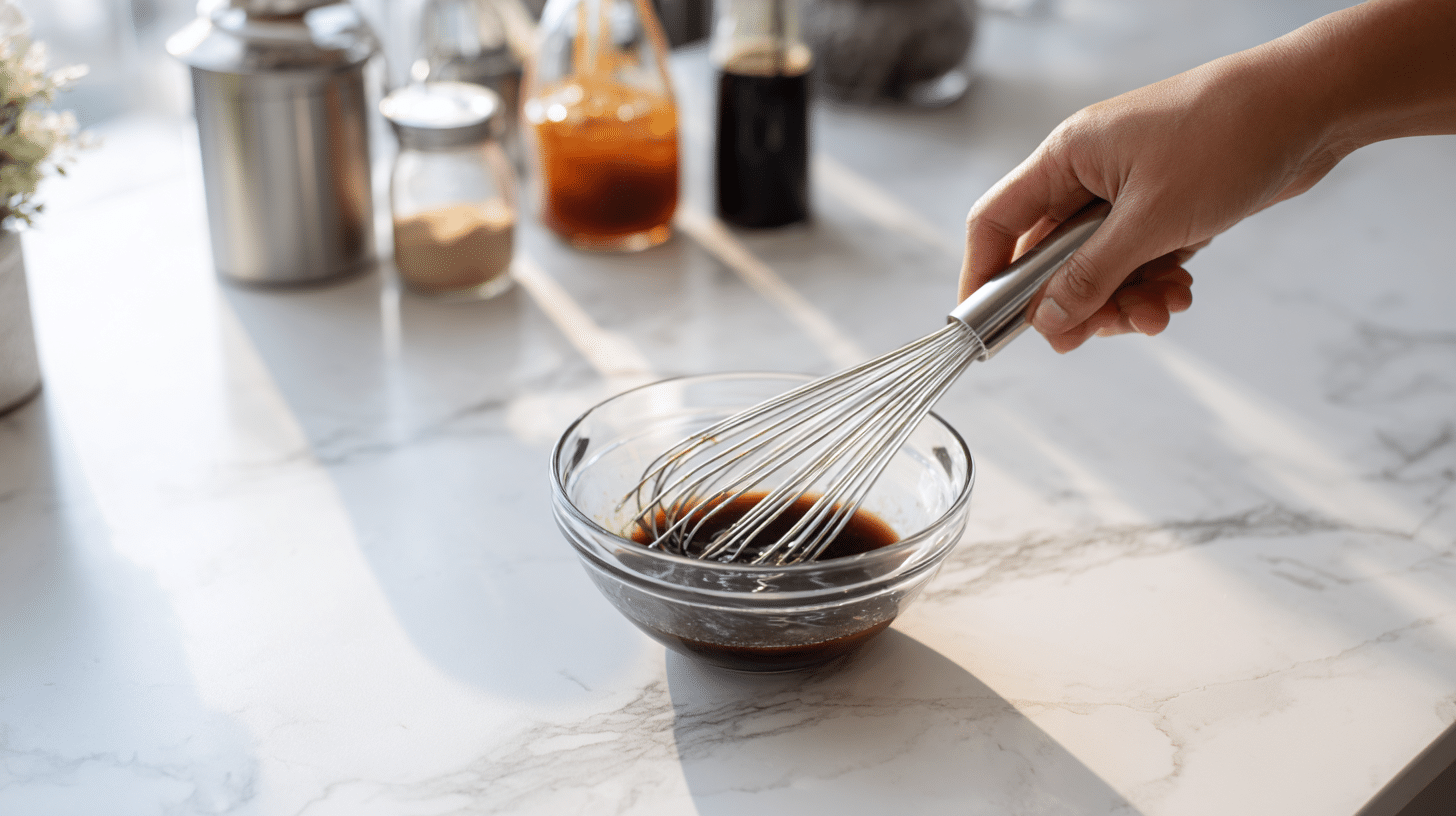
Whisk soy sauce, maple syrup, chili garlic sauce, and rice vinegar in a bowl until completely smooth. The mixture should be well-blended with no separation of ingredients or streaks.
Use a wire whisk to ensure the maple syrup remains smooth and evenly consistent throughout.
Pro Tip: Use room temperature ingredients for easier mixing – cold maple syrup can be stubborn to blend and may create streaks.
2. Add All Spices and Blend
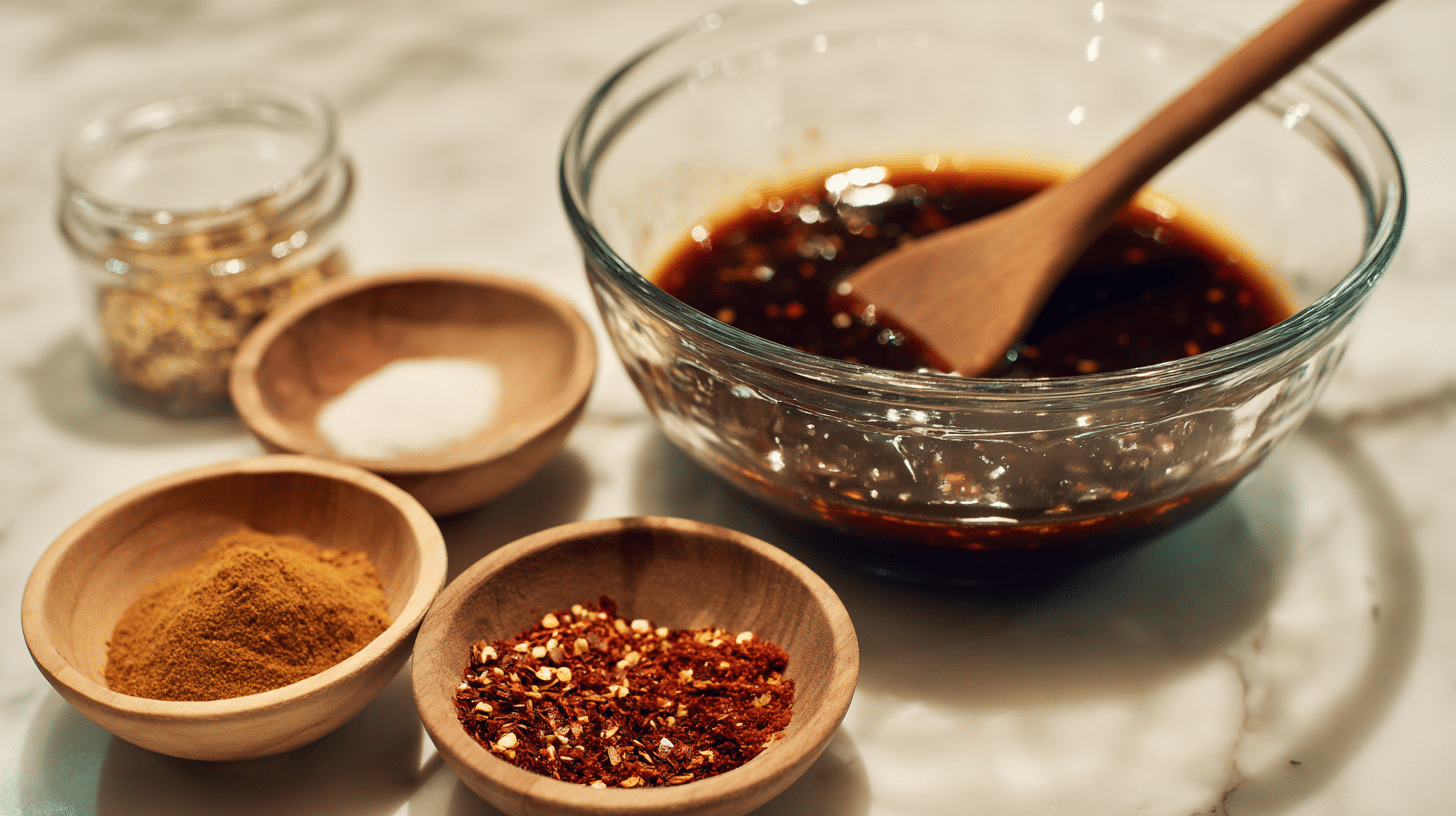
Stir in the Chinese five-spice, red pepper flakes, garlic powder, and ground ginger until fully incorporated. Mix thoroughly to ensure every drop has the complete spice profile without any dry pockets.
The spices should be distributed evenly throughout the liquid base, creating a unified sauce that delivers a consistent flavor.
Pro Tip: Sift your spice powders before adding to prevent lumps – this creates silky smooth texture that coats ingredients beautifully.
3. Rest and Adjust
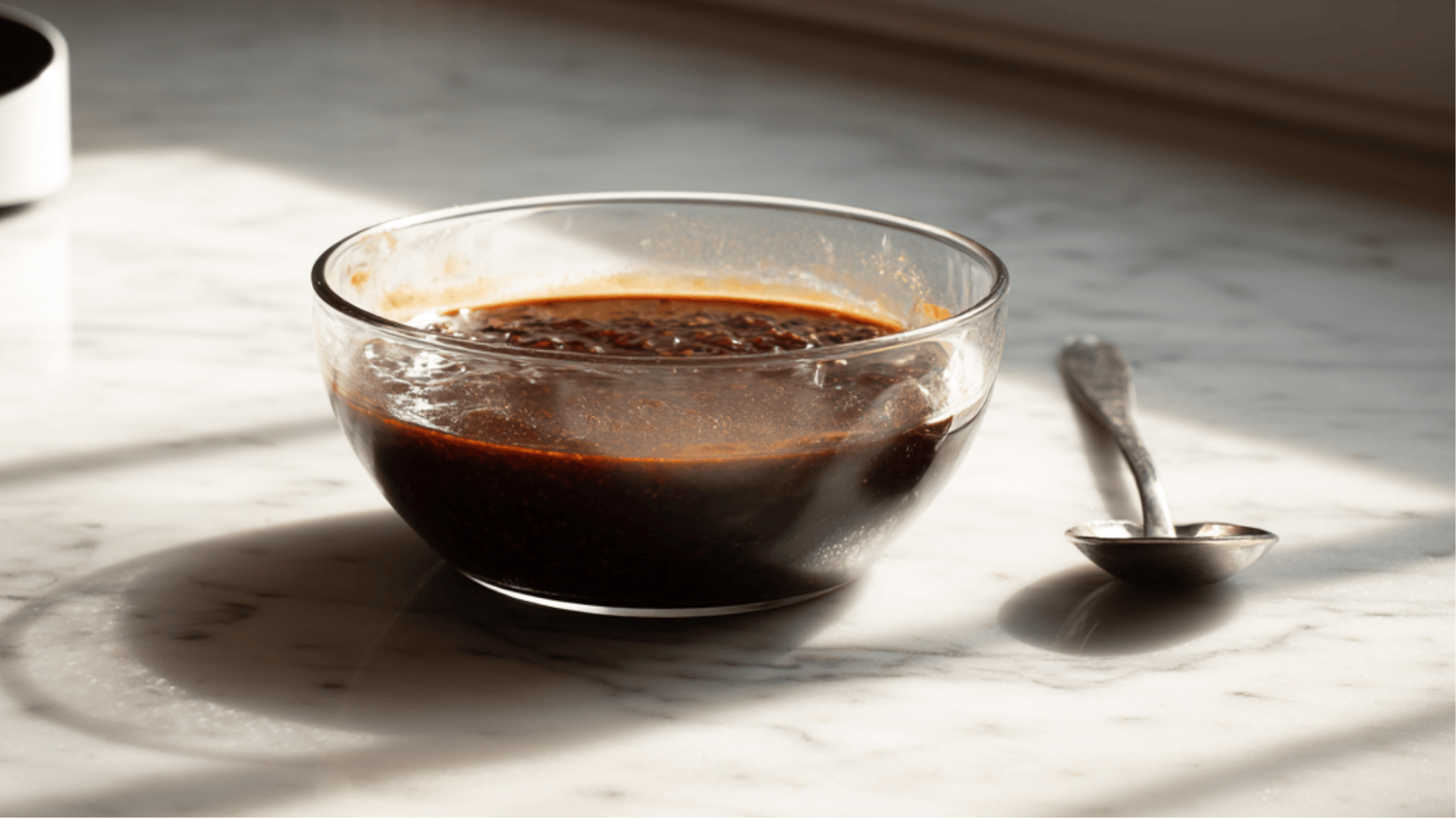
Let the sauce sit for 10 minutes to allow the spices to hydrate and release their full flavor potential. The resting time allows dried spices to absorb moisture and release their essential oils for maximum impact.
Store in refrigerator for up to 2 weeks, where flavors will continue to develop and meld together.
Pro Tip: Taste after resting and add more five spice for deeper warmth, or extra chili garlic sauce for increased heat.
Recipe Details
| Information | Details |
|---|---|
| Prep Time | 5 minutes |
| Cook Time | 0 minutes |
| Total Time | 5 minutes |
| Category | Sauce / Condiment |
| Method | No-cook |
| Cuisine | Chinese |
| Yield | 6 tbsp |
Nutrition Facts
| Nutrient | Per 2 Tbsp (32g) |
|---|---|
| Calories | 60 kcal |
| Fat | 1g |
| Carbs | 13g |
| Sugar | 11g |
| Protein | 0g |
| Sodium | 250mg |
This sauce is relatively high in carbohydrates, primarily due to the added sugar and soy sauce, with most of its calories derived from sugar and carbohydrates.
Rich Chiu Chow Chili Oil That Rules Your Kitchen
This traditional chili oil delivers all the intensity of Cantonese cuisine without restaurant equipment and professional training.
The slow-heating approach creates an aromatic condiment that serves as a flavor enhancer, cooking oil, or table sauce with incredible depth and complexity.
The combination of fresh chilies and dried flakes makes this a complete heat experience that satisfies serious spice lovers while providing authentic southern Chinese taste.
What makes this oil special is the slow heating process, which extracts maximum flavor from both chilies and garlic, creating layers of heat that build gradually on your palate.
The garlic becomes sweet and mellow during cooking while maintaining its pungent kick, and the oil carries all these flavors beautifully to whatever dish you’re preparing.
What You’ll NeedFor the Chili Base:
For the Oil Mixture:
|
Step-by-Step Instructions
This chili oil combines traditional grinding with modern convenience cooking for the best flavor extraction. The key is slow heating and gradual flavor building to create maximum aromatic intensity.
1. Prepare the Chili-Garlic Base
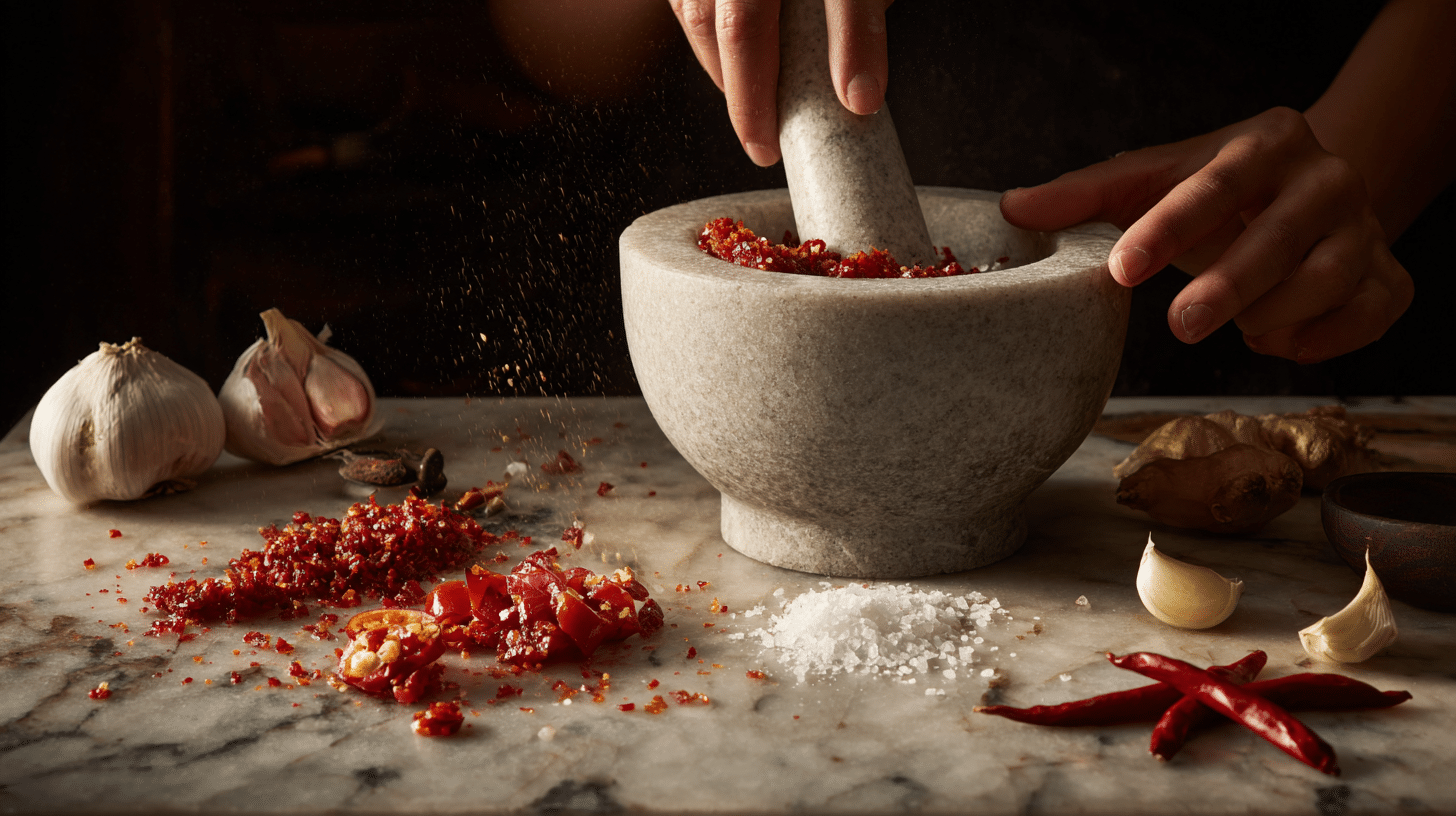
Use a mortar and pestle to grind sliced chilies with salt until a coarse paste forms, then add garlic cloves and continue grinding.
The grinding process releases essential oils from both chilies and garlic, creating the foundation for deep flavor. Work in small batches if your mortar is small – some texture adds character to the final oil.
Pro Tip: Grind in circular motions rather than just pounding – this breaks down cell walls more effectively and releases more flavor compounds.
2. Heat Oil and Add Chilies
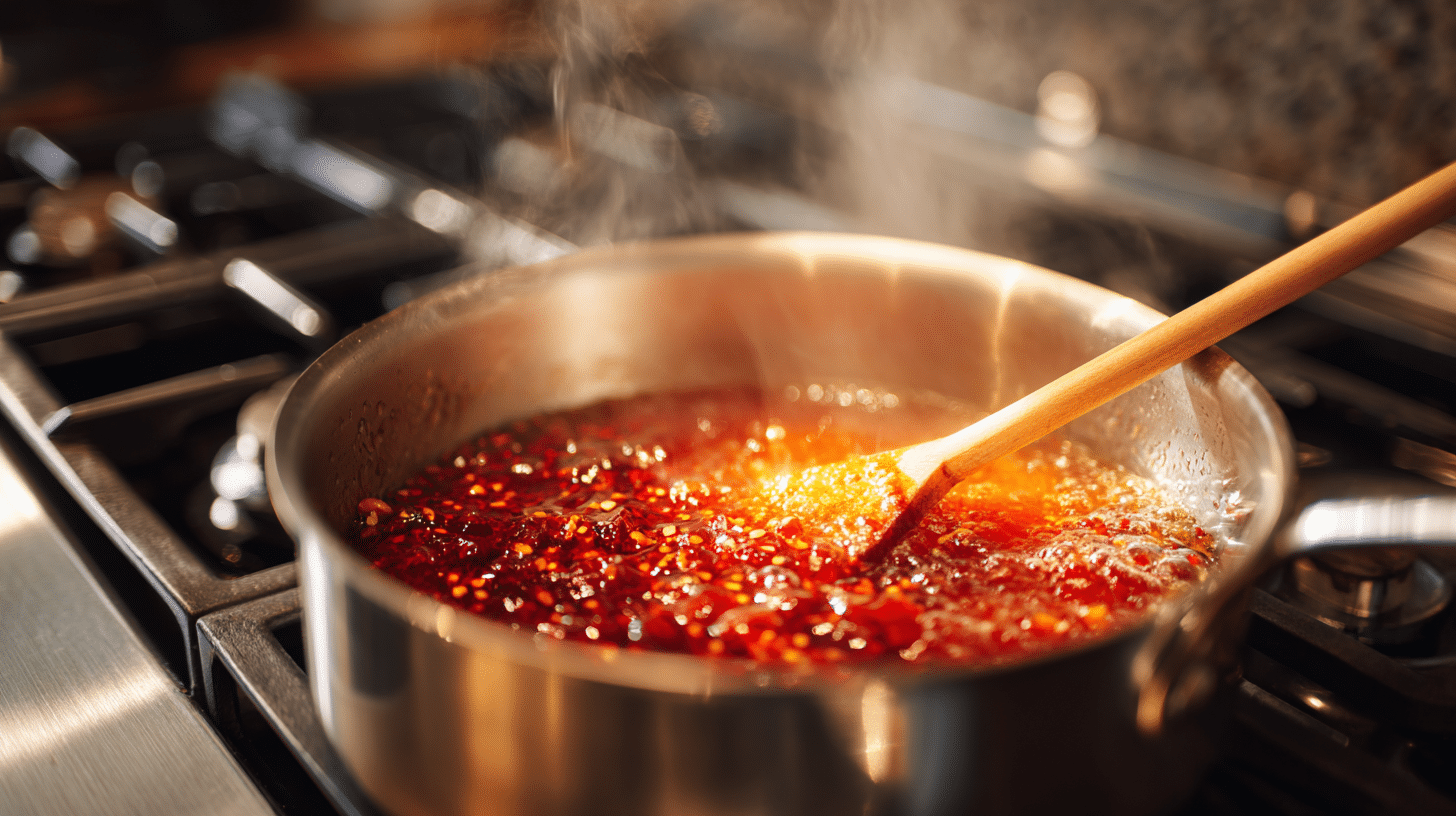
Heat neutral oil in a heavy pan until hot but not smoking, then carefully add chili-garlic mixture and Sichuan flakes. Cook gently on low heat, stirring frequently for 15 minutes, until the oil bubbles gently around the chilies.
Watch for the color to deepen to beautiful red as the chilies release their essence into the oil.
Pro Tip: Use a wooden spoon for stirring – metal can conduct too much heat and potentially burn the mixture on contact.
3. Finish and Cool
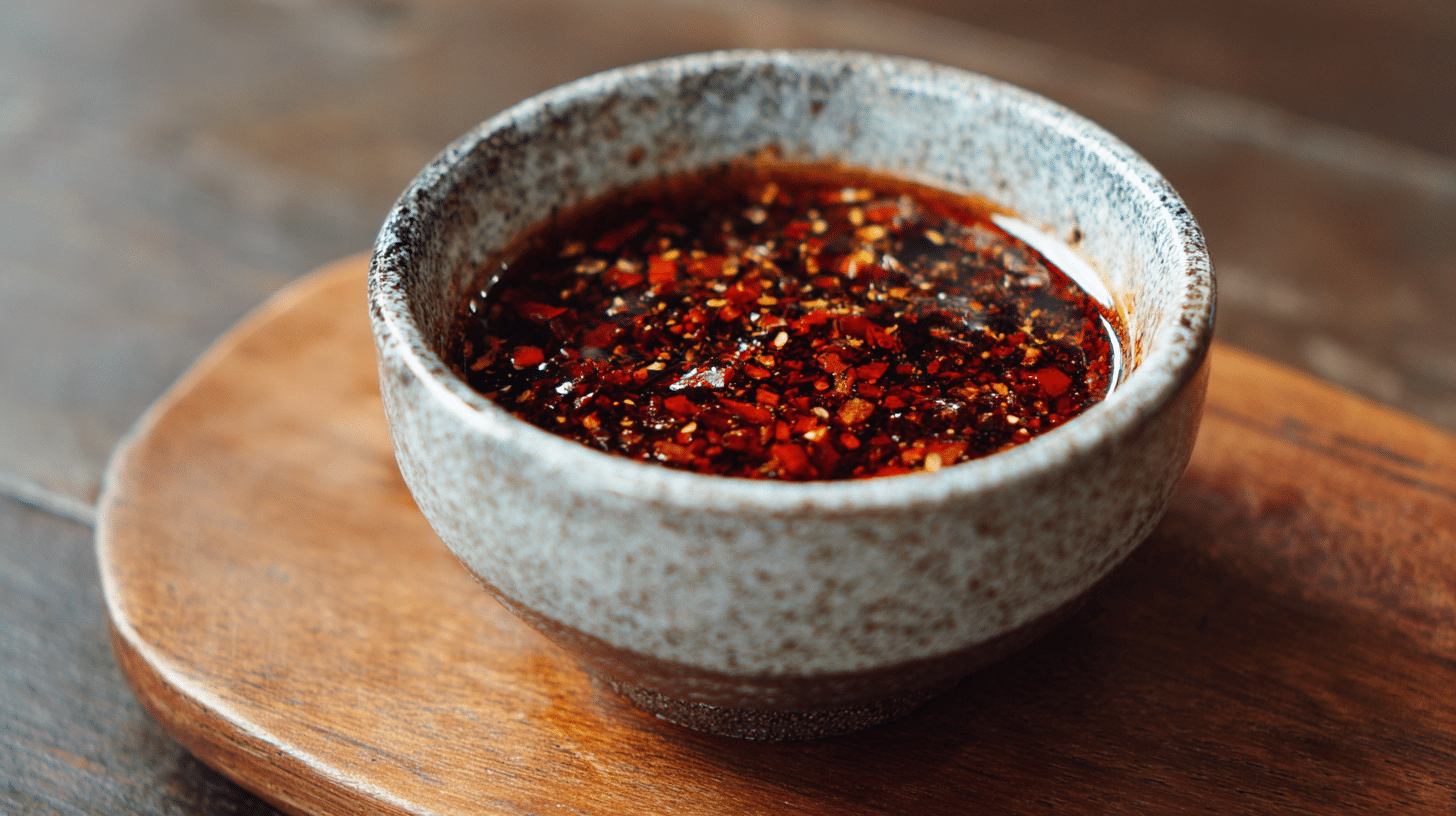
Stir the sugar into the sauce and cook for 5 minutes, until the sauce has a fragrant aroma. Move from the heat and eat it cool, allowing it to help balance the heat. Meanwhile, soy sauce adds a depth of umami, making this more than just spicy oil.
Allow to cool entirely before jarring to prevent condensation that could spoil the oil during storage.
Pro Tip: Don’t strain the oil unless you prefer it smooth – leaving chili pieces continues developing flavor during storage.
Recipe Details
| Information | Details |
|---|---|
| Prep Time | 15 minutes |
| Cook Time | 20 minutes |
| Total Time | 35 minutes |
| Category | Sauce / Condiment |
| Method | Stovetop |
| Cuisine | Chinese |
| Yield | 1.5 cups |
Nutrition Facts
| Nutrition Information | Per 1 tbsp (15g) |
|---|---|
| Calories | 100 kcal |
| Fat | 11g |
| Carbs | 2g |
| Sugar | 1g |
| Protein | 0.5g |
| Sodium | 150mg |
Fiery Lazadzhan Paste That Commands Respect
This traditional Central Asian paste delivers all the bold heat of Uyghur cuisine without specialized equipment and complex preparation.
The oil-pouring technique creates an intense condiment that serves as a flavor base, meat rub, or table sauce with incredible potency and depth.
The simple combination of chilies and garlic makes this a pure heat experience that satisfies serious spice enthusiasts while providing authentic Central Asian taste.
What makes this paste special is its raw intensity – there’s no cooking to mellow the heat, just pure chili and garlic power activated by hot oil.
What You’ll NeedFor the Paste Base:
For the Oil Treatment:
|
Step-by-Step Instructions
This paste combines ancient grinding techniques with hot oil activation for maximum flavor impact. The key is achieving the proper grinding texture and maintaining the correct oil temperature for a perfect heat explosion.
1. Prepare Chili-Garlic Base
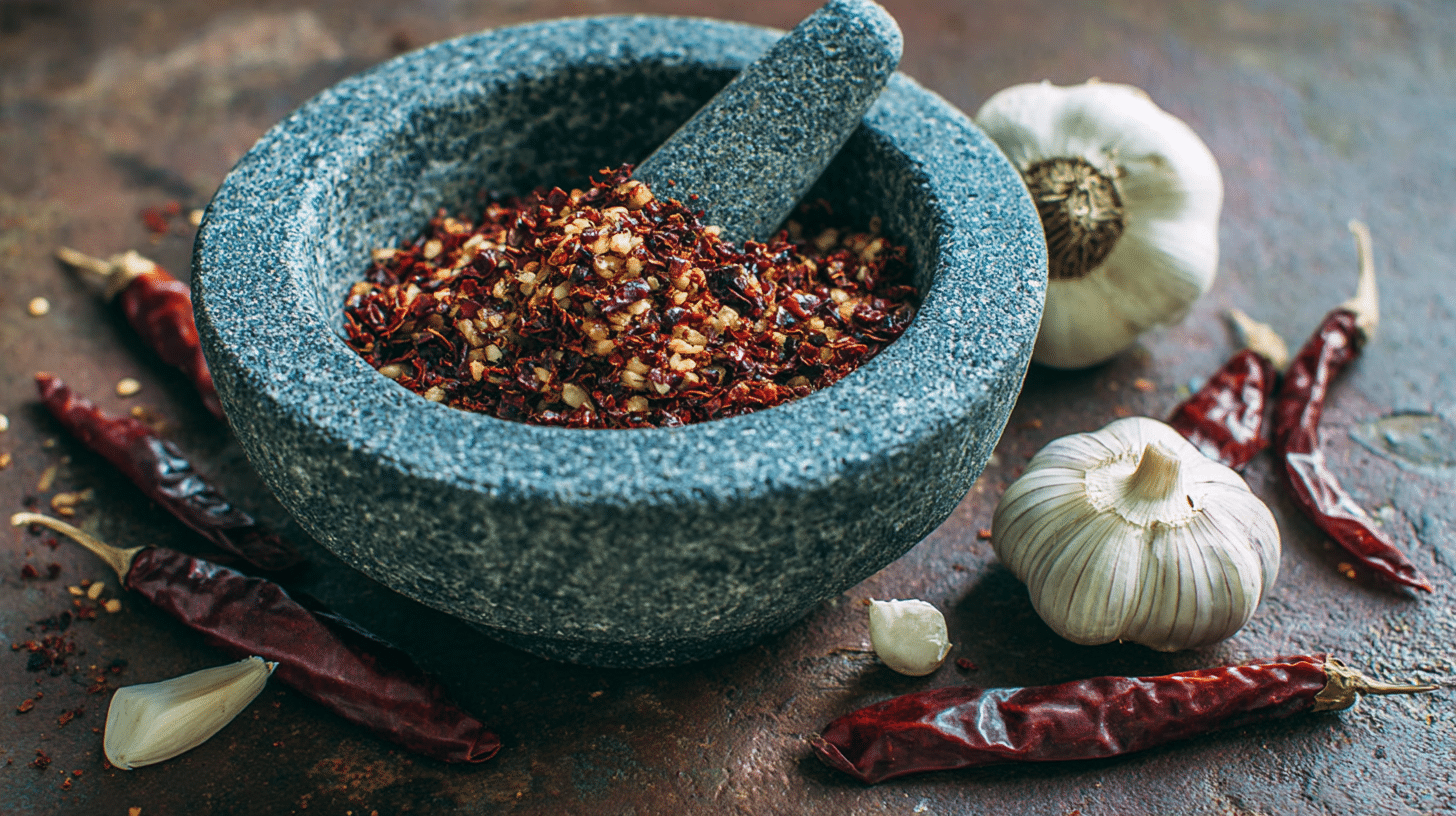
Remove the stems and seeds from the dried chilies, then grind them with coarse salt using a mortar and pestle until chunky. Add garlic cloves and continue grinding until well combined and aromatic throughout your kitchen.
The salt acts as an abrasive, helping to break down tough chili skins while drawing out essential oils.
Pro Tip: Wear gloves during grinding and avoid touching your face – this paste is seriously potent and oils linger for hours.
2. Heat Oil to Perfection
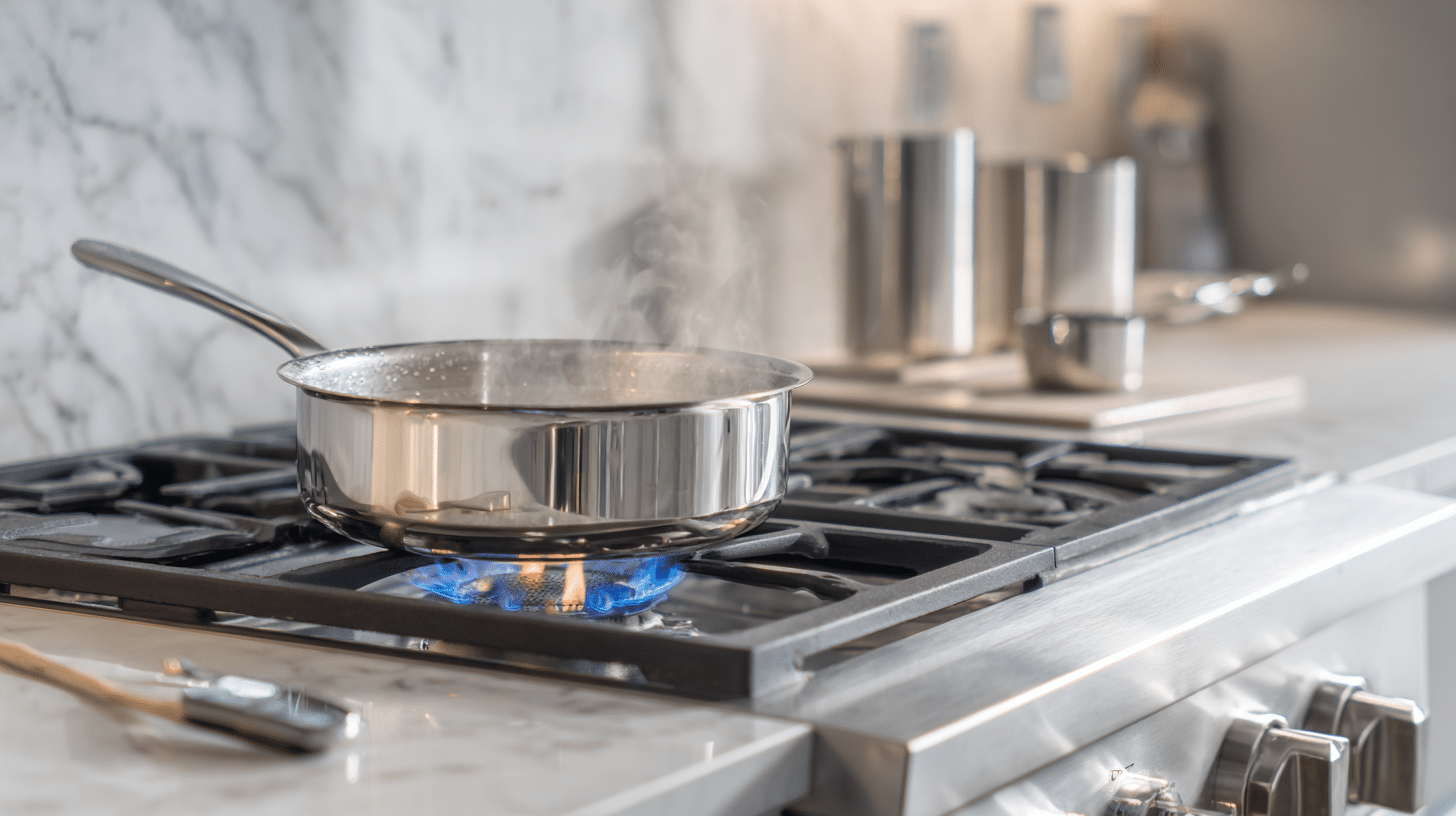
Heat neutral oil in a large, heavy pot until very hot but not smoking (around 300°F). Test with a drop of paste that should sizzle immediately and vigorously when it hits the oil.
Use a heavy-bottomed pan to maintain even heat distribution and prevent hot spots that could scorch your paste.
Pro Tip: If you don’t have a thermometer, drop a small piece of garlic – it should sizzle vigorously but not brown immediately.
3. Activate with Hot Oil
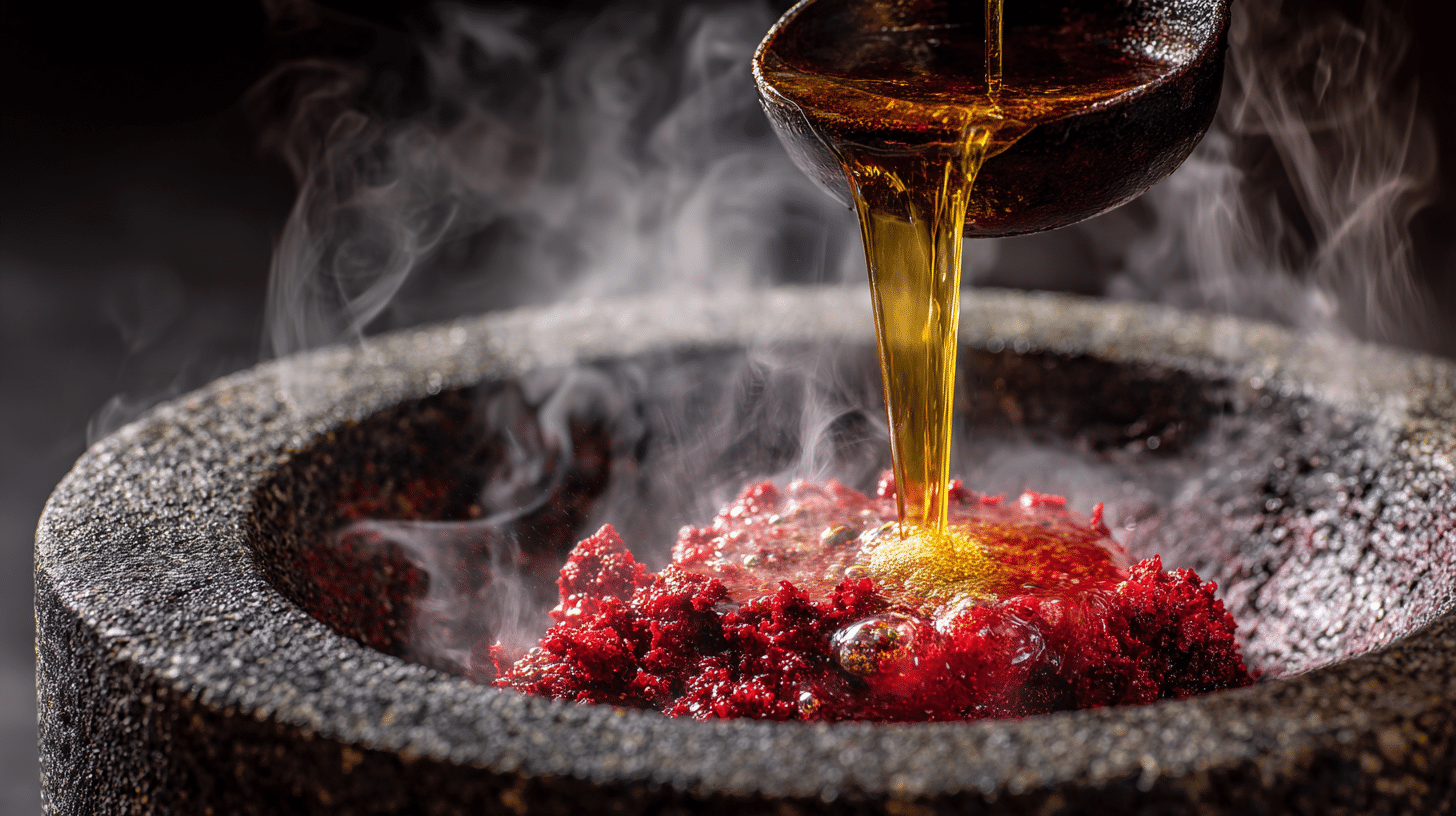
Slowly pour hot oil over chili-garlic paste in 3-4 additions, stirring constantly as it sizzles and blooms dramatically. Add extra salt to taste and let the mixture cool completely before storing it in sterilized containers.
The sizzling reaction releases volatile compounds that create the paste’s signature intensity and incredible aroma.
Pro Tip: Pour oil in a thin stream while stirring continuously – this prevents clumping and ensures proper activation throughout.
Recipe Details
| Information | Details |
|---|---|
| Prep Time | 20 minutes |
| Cook Time | 5 minutes |
| Total Time | 25 minutes |
| Category | Sauce / Condiment |
| Method | Oil Activation |
| Cuisine | Central Asian |
| Yield | 3/4 cup |
Nutrition Facts
| Nutrition Information | Per 1 tbsp (15g) |
|---|---|
| Calories | 60 kcal |
| Fat | 7g |
| Carbs | 2g |
| Protein | 0.3g |
| Sodium | 100mg |
Bold Korean Gochujang Sauce for Everything
This sauce delivers all the flavors of Korean cuisine without requiring complicated preparation and assembly.
The no-cook approach yields a flexible condiment that serves as a dip, marinade, or stir-fry base, requiring minimal cleanup.
The addition of sesame and vinegar makes this a complete flavor bomb that satisfies spicy food lovers while providing authentic Korean taste in every drop.
What sets this sauce apart is its perfect balance of sweet, salty, spicy, and tangy elements that work together to create something truly special.
The fermented gochujang brings deep, complex heat that’s different from regular hot sauce – it has layers of flavor that develop on your palate.
What You’ll NeedFor the Sauce Base:
For the Flavor Balance:
Optional Add-ins:
|
Step-by-Step Instructions
This sauce builds layers of umami and heat with simple mixing techniques that create perfect flavor harmony. The key is to achieve proper balancing and tasting to create your ideal flavor profile, which matches your intended use.
1. Mix Base Ingredients
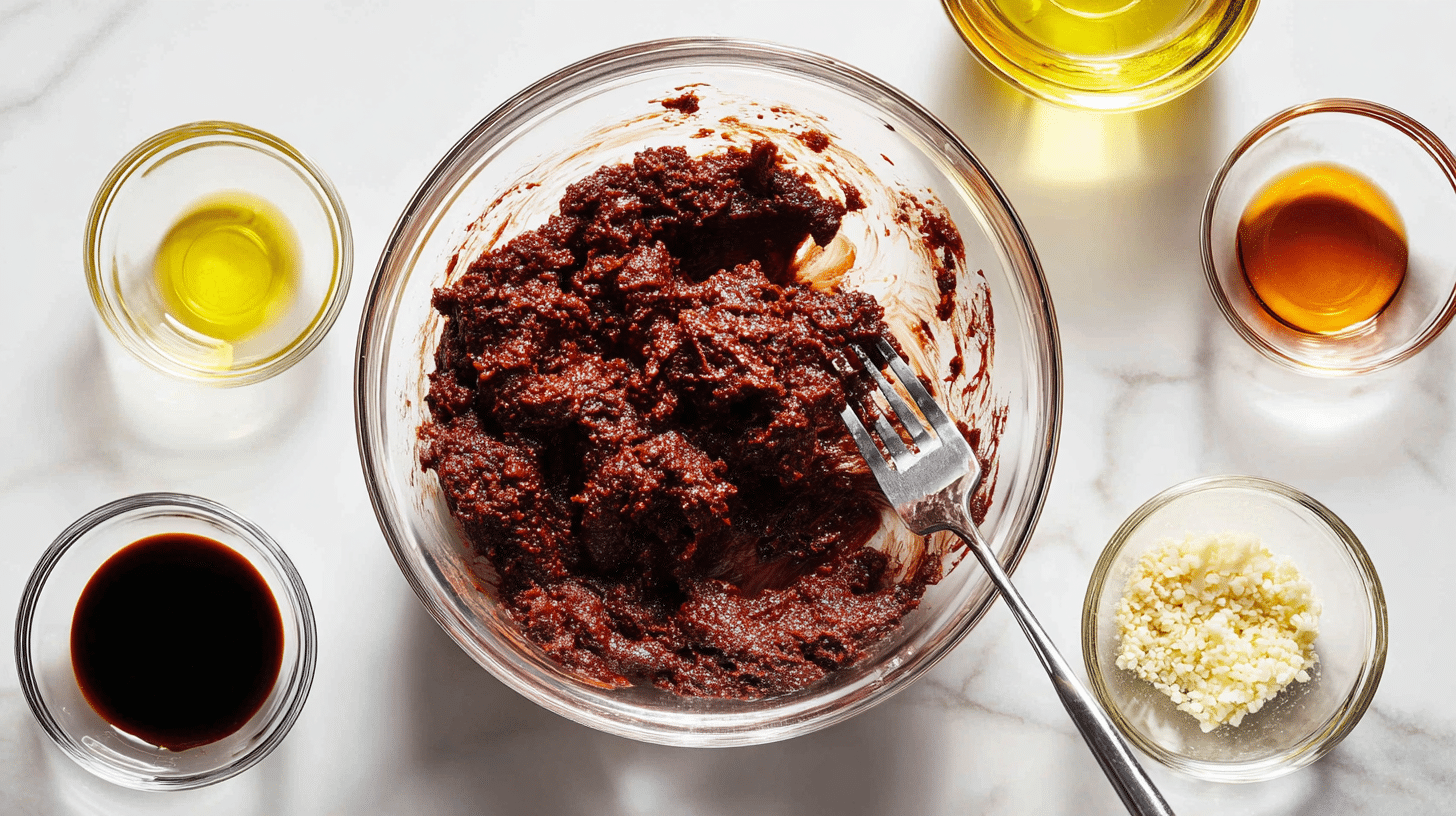
Combine gochujang, soy sauce, sesame oil, and minced garlic in a bowl, whisking until completely smooth with no lumps.
The gochujang can be thick and stubborn, so take time to break it down entirely for even distribution.
Use a fork to mash any stubborn chunks before whisking to ensure a silky consistency throughout the mixture.
Pro Tip: Let gochujang come to room temperature before mixing – cold fermented paste is much harder to blend smoothly.
2. Add Sweet and Tang
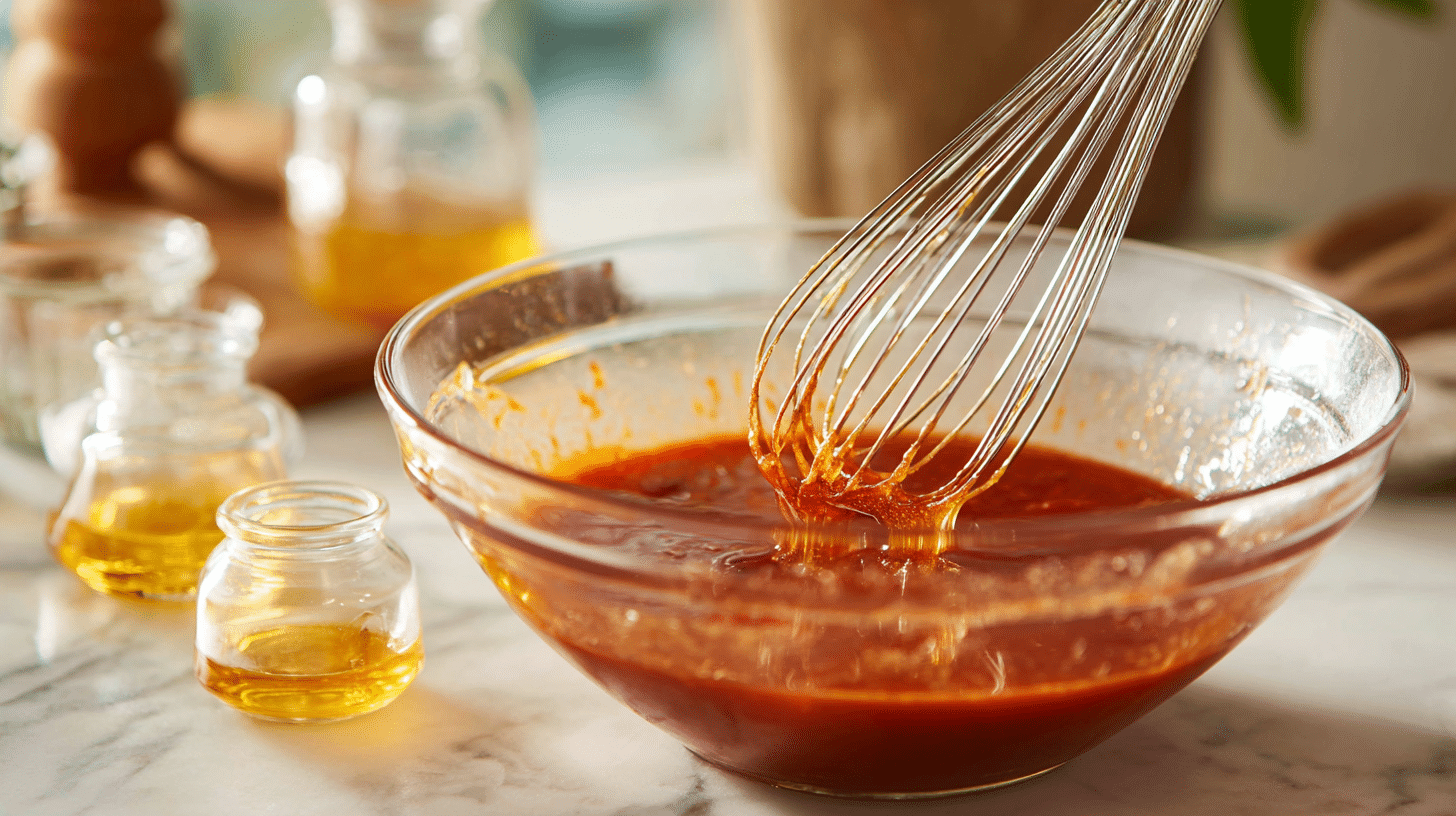
Stir in rice vinegar and honey until fully incorporated, creating a perfect balance between sweet, salty, and tangy elements.
Taste and adjust the sweetness or acidity according to the intended use: more honey for marinades and more vinegar for dips. The honey should dissolve completely, while he vinegar adds brightness that cuts through the rich flavors.
Pro Tip: Warm the honey slightly in the microwave for 10 seconds to make it blend easily and prevent crystallization.
3. Garnish and Store
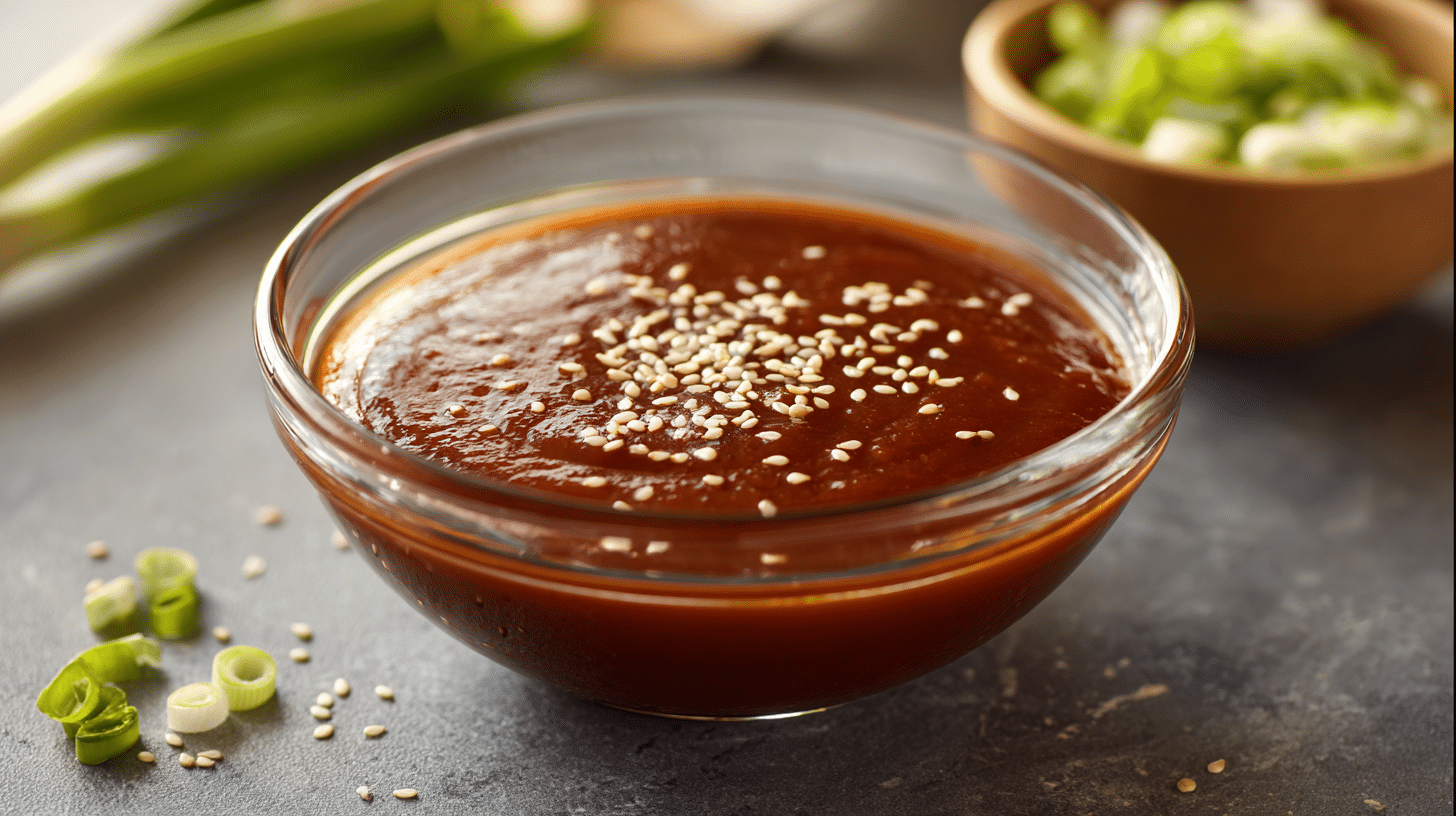
Sprinkle with sesame seeds and optional garnishes, such as green onions, for added texture and visual appeal. Store in refrigerator for up to 2 weeks in an airtight container where flavors continue to develop over time.
The sauce will thicken slightly when cold but return to its consistency at room temperature.
Pro Tip: Toast sesame seeds in a dry pan for 2-3 minutes before adding – this intensifies their nutty flavor and aroma.
Recipe Details
| Information | Details |
|---|---|
| Prep Time | 5 minutes |
| Cook Time | 0 minutes |
| Total Time | 5 minutes |
| Category | Sauce / Condiment |
| Method | No-cook |
| Cuisine | Korean |
| Yield | 8 tbsp |
Nutrition Facts
| Nutrition Information | Per 1 tbsp (15g) |
|---|---|
| Calories | 60 kcal |
| Fat | 7g |
| Carbs | 2g |
| Protein | 0.3g |
| Sodium | 100mg |
Popular Dishes to Make with These Sauces
Change your weekly meal routine with these crowd-pleasing dishes that showcase each sauce’s unique character and cultural heritage:
1. Szechuan Sauce Applications
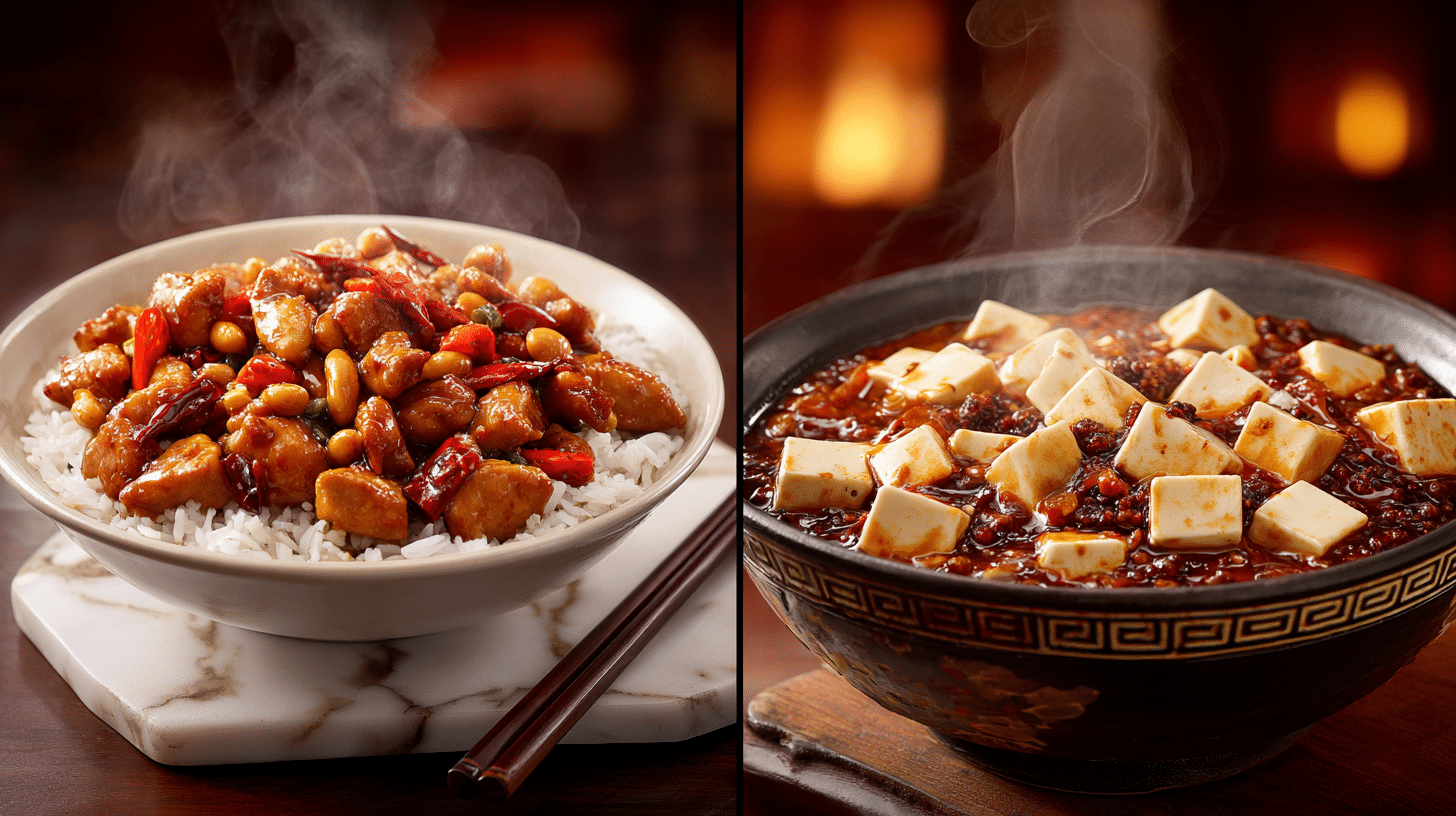
This sweet-spicy sauce improves simple ingredients into restaurant-quality dishes, infusing them with complex five-spice warmth and maple sweetness.
The flexible consistency works perfectly as a stir-fry base, glaze, or dipping sauce for authentic Szechuan flavors.
Gong Bao Chicken (Kung Pao Chicken)
This classic Szechuan dish originated in the 19th century, named after Ding Baozhen, a Qing Dynasty official. Initially featuring diced chicken, peanuts, and chili peppers, it represents the perfect balance of Szechuan cuisine.
Flavor Profile: Sweet heat builds gradually with complex five-spice warmth, while maple syrup creates caramelized edges on tender chicken.
The sauce coats each ingredient, delivering layers of savory-sweet intensity with aromatic depth that lingers pleasantly.
Mapo Doufu (Szechuan Tofu)
Created by a pockmarked grandmother (mapo) in Chengdu during the 1860s, this silky tofu dish became legendary for its perfect balance of heat and umami richness.
Flavor Profile: The sauce penetrates soft tofu cubes with sweet-spicy complexity, while five-spice adds warm, aromatic notes that complement the heat.
Each bite delivers comforting richness with building warmth that satisfies without overwhelming.
2. Chiu Chow Chili Oil Uses
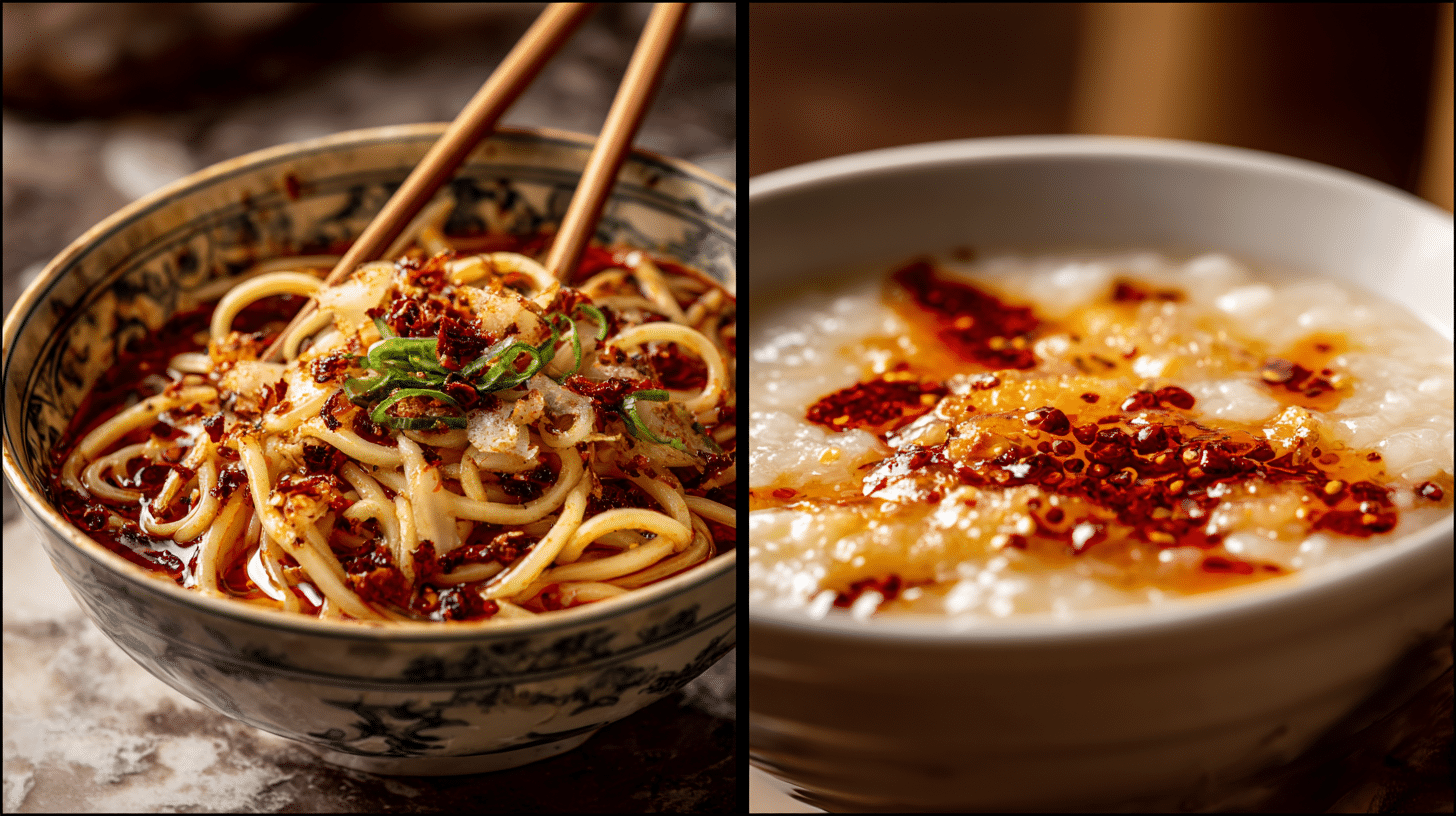
This aromatic oil modifies simple dishes into complex flavor experiences with layers of garlic-infused heat.
The slow-heated preparation creates intense depth, adding gracefulness to dishes ranging from noodles to rice.
Dan Dan Noodles
Street food from Szechuan province, traditionally carried by vendors on shoulder poles (dan dan). This simple noodle dish showcases how quality chili oil can change basic ingredients into something extraordinary.
Flavor Profile:Aromatic chili oil coats each noodle strand with layers of heat that build gradually, while garlic provides sweet, mellow depth.
The oil carries intense flavors that create warmth and satisfaction with every slurp.
Chiu Chow Congee
Traditional rice porridge from the Chaoshan region, eaten as comfort food and hangover cure. The addition of chili oil modifies simple congee into a complex, warming meal.
Flavor Profile: Silky rice porridge provides a neutral canvas for the oil’s intense aromatics, creating comforting heat that builds slowly.
The garlic-infused oil adds depth and complexity to each spoonful, delivering satisfying warmth.
3. Lazadzhan Paste Applications

This intense paste brings authentic Central Asian fire with uncompromising heat that commands respect from serious spice enthusiasts.
The raw chili and garlic combination creates bursts of flavor that build gradually with every bite.
Xinjiang Lamb Kebabs
Traditional grilled meat from China’s western frontier, where Uyghur cooks have perfected the art of balancing intense spices with tender lamb over centuries.
Flavor Profile:The paste forms a fiery crust on grilled lamb, delivering waves of intense heat balanced by the meat’s richness.
Each bite combines smoky char with pure chili power, creating an unforgettable eating experience.
Central Asian Lagman Noodles
Hand-pulled noodle soup, representing the culinary fusion of the Silk Road, where spice pastes like lazadzhan add the heat that defines this hearty comfort food.
Flavor Profile:Adding small amounts to broth creates a warming heat that spreads throughout the soup, while the paste’s intensity penetrates tender noodles and vegetables.
The raw garlic and chili combination adds depth that develops with each spoonful.
4. Korean Gochujang Sauce Applications

This flexible sauce offers a rich, fermented umami depth, complemented by a perfect balance of sweet, spicy, and tangy elements.
The complex flavor profile complements everything from rice bowls to grilled meats, adding authentic Korean taste.
Bibimbap
Korea’s most famous mixed rice dish is traditionally eaten to use up leftover banchan (side dishes). The gochujang sauce changes simple ingredients into a harmonious, satisfying meal.
Flavor Profile:Sweet-spicy fermented heat binds rice and vegetables together, creating a complex depth of umami.
The sauce’s tangy brightness cuts through rich ingredients, building a pleasant warmth that improves every component.
Korean Fried Chicken (Dakgangjeong)
Modern Korean comfort food that gained international popularity, where gochujang-based sauces create the perfect balance of sweet, spicy, and savory flavors.
Flavor Profile:Sticky glaze coats crispy chicken with layers of fermented heat and honey sweetness.
The sauce penetrates the coating while maintaining its crunch, delivering a complex umami flavor with each bite.
Make Every Meal Special!
These four asian spicy recipes prove that love for heat can create completely different meal experiences to keep dinner enjoyable and satisfying.
Each option offers unique benefits: Szechuan sauce for a sweet and spicy balance, Chiu Chow oil for aromatic depth, Lazadzhan paste for raw intensity, and Korean sauce for daily flexibility.
The simple cooking methods mean minimal hands-on time while maximum flavor develops, making these perfect for home cooks who want authentic taste without complicated techniques.
The beauty of these recipes lies in their ability to bring people together around shared meals that create lasting memories.
Spicy food breaks down barriers and creates excitement that turns ordinary dinners into special occasions, if you’re cooking for adventurous family members or introducing friends to new flavors.
Add a comment below sharing which of these four Asian spicy recipes has become your household favorite!








